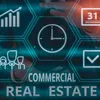Emerging trends in commercial real estate: Remodelling office spaces in a post-Covid world
As businesses slowly wean away from WFH and gear up for a return to physical offices, they are exploring coworking spaces and hub-and-spoke models to make optimal use of space while adhering to social distancing and safety norms.
As the country eases its lockdown rules, businesses are gradually getting back on their feet amid the pandemic. Organisations were forced to be creative overnight, swiftly embracing new norms of functioning. As safety and health took priority, Work-from-home (WFH), a model that was sparsely adopted by select few companies in the world, became the best alternative for business survival.
However, even as workplace flexibility gains deeper acceptability, corporates are already finding ways to get back to the office as the initial euphoria of WFH starts to wane and businesses are itching to bring back to a semblance of normalcy. Though a far cry from returning to the pre-COVID days, the only way to conquer this phase is to accept the new normal.
Corporates are now stepping up their game and putting their best efforts to create a safe workspace as they try to welcome back their workforce. Given the various intangible advantages of bringing employees together in offices while bearing in mind their well-being, existing office spaces are being relooked at to adjust to the new environment.
Rejig in workspace
With social distancing the new mantra in COVID times, common areas, meeting rooms and collaboration spaces are being reorganised to comply with the necessary safety norms. Further, we also foresee de-clustering of large work floors resulting in reducing the density of workspace. Over the next few months, companies will have to work with less than 50% workforce to adhere to social distancing guidelines. Thus, for new offices, space requirement will be lower.
Post-pandemic, emotional and physical wellbeing of employees will hold paramount importance and companies will adopt a holistic approach to maintain it. Gymnasiums, meditation areas and yoga rooms will replace or be built along with usual common areas, meeting rooms and desks. They will be a part of office premises rather than a commercial complex.
Corporate office spaces are also going ‘touchless’ with doors, toilet fixtures and other amenities like elevators. Mobile apps and sensors are increasingly being used to keep a check on the occupancy within the office premise.
Facility managers are already implementing new design ideas to provide flexible and segregated spaces. We will witness growth in the popularity of new coating materials with anti-viral, anti-microbial properties to create safer offices.
Rise of alternate workplace model
Cost-saving and optimisation is of utmost importance as organisations cope with uncertain business environment. Coworking office spaces are likely to find relevance in such circumstances as companies adopt a CAPEX light model.
Some of the companies are already exploring flexi-spaces or managed office spaces where they would not have to shell out heavy capital investment. Not only do these workspace models help in saving real estate costs, but the shorter lock-in-period for such spaces also works as an advantage. As most companies are in a wait-and-watch mode amid uncertain times, they are not willing to take long-term shots; they are opting for coworking and flexi- spaces.
Another trend that we foresee emerging in the coming months is the rise of ‘hub and spoke’ models. Companies will have a head office as ‘hub’ in the city centre or primary locality and smaller ‘spoke’ offices in other locations. The size and number of spokes depends on employee strength of the company.
Will commercial real estate sector continue to thrive amid the pandemic?
The answer is yes. While the pandemic has led to a temporary halt in the growth story of India’s booming office market which until last year had seen a record leasing, the situation is set to change. Post-pandemic, various sectors such as ed-tech, health, logistics and e-retail will witness a boom. They will lease office spaces that are vacant at the moment. Hence, even though the vacancy rates are currently high, they are likely to come down over the next few quarters.
(Disclaimer: The views and opinions expressed in this article are those of the author and do not necessarily reflect the views of YourStory.)








